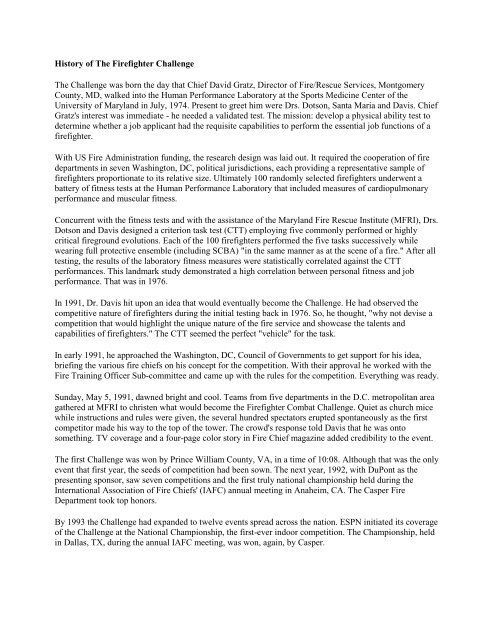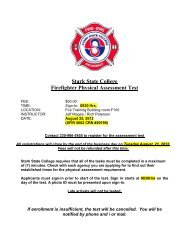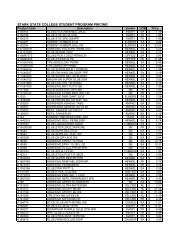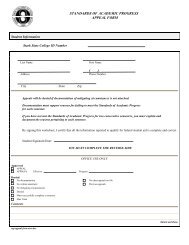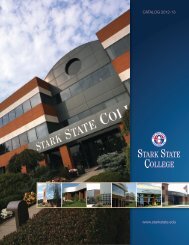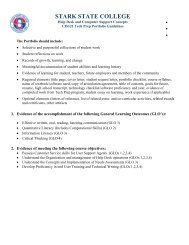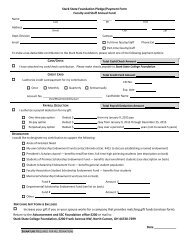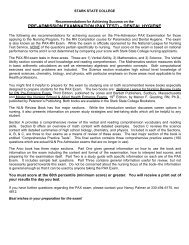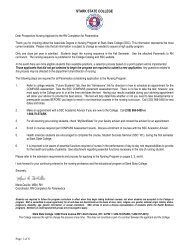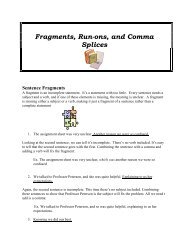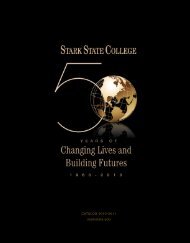Firefighter Physical - Stark State College
Firefighter Physical - Stark State College
Firefighter Physical - Stark State College
- No tags were found...
Create successful ePaper yourself
Turn your PDF publications into a flip-book with our unique Google optimized e-Paper software.
History of The <strong>Firefighter</strong> ChallengeThe Challenge was born the day that Chief David Gratz, Director of Fire/Rescue Services, MontgomeryCounty, MD, walked into the Human Performance Laboratory at the Sports Medicine Center of theUniversity of Maryland in July, 1974. Present to greet him were Drs. Dotson, Santa Maria and Davis. ChiefGratz's interest was immediate - he needed a validated test. The mission: develop a physical ability test todetermine whether a job applicant had the requisite capabilities to perform the essential job functions of afirefighter.With US Fire Administration funding, the research design was laid out. It required the cooperation of firedepartments in seven Washington, DC, political jurisdictions, each providing a representative sample offirefighters proportionate to its relative size. Ultimately 100 randomly selected firefighters underwent abattery of fitness tests at the Human Performance Laboratory that included measures of cardiopulmonaryperformance and muscular fitness.Concurrent with the fitness tests and with the assistance of the Maryland Fire Rescue Institute (MFRI), Drs.Dotson and Davis designed a criterion task test (CTT) employing five commonly performed or highlycritical fireground evolutions. Each of the 100 firefighters performed the five tasks successively whilewearing full protective ensemble (including SCBA) "in the same manner as at the scene of a fire." After alltesting, the results of the laboratory fitness measures were statistically correlated against the CTTperformances. This landmark study demonstrated a high correlation between personal fitness and jobperformance. That was in 1976.In 1991, Dr. Davis hit upon an idea that would eventually become the Challenge. He had observed thecompetitive nature of firefighters during the initial testing back in 1976. So, he thought, "why not devise acompetition that would highlight the unique nature of the fire service and showcase the talents andcapabilities of firefighters." The CTT seemed the perfect "vehicle" for the task.In early 1991, he approached the Washington, DC, Council of Governments to get support for his idea,briefing the various fire chiefs on his concept for the competition. With their approval he worked with theFire Training Officer Sub-committee and came up with the rules for the competition. Everything was ready.Sunday, May 5, 1991, dawned bright and cool. Teams from five departments in the D.C. metropolitan areagathered at MFRI to christen what would become the <strong>Firefighter</strong> Combat Challenge. Quiet as church micewhile instructions and rules were given, the several hundred spectators erupted spontaneously as the firstcompetitor made his way to the top of the tower. The crowd's response told Davis that he was ontosomething. TV coverage and a four-page color story in Fire Chief magazine added credibility to the event.The first Challenge was won by Prince William County, VA, in a time of 10:08. Although that was the onlyevent that first year, the seeds of competition had been sown. The next year, 1992, with DuPont as thepresenting sponsor, saw seven competitions and the first truly national championship held during theInternational Association of Fire Chiefs' (IAFC) annual meeting in Anaheim, CA. The Casper FireDepartment took top honors.By 1993 the Challenge had expanded to twelve events spread across the nation. ESPN initiated its coverageof the Challenge at the National Championship, the first-ever indoor competition. The Championship, heldin Dallas, TX, during the annual IAFC meeting, was won, again, by Casper.


